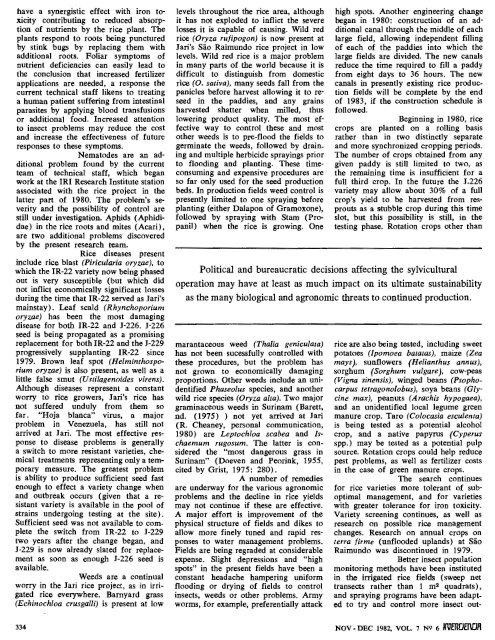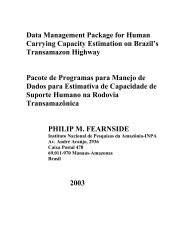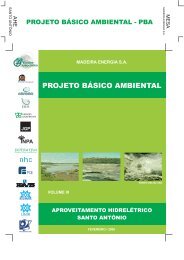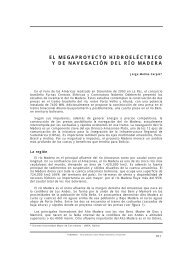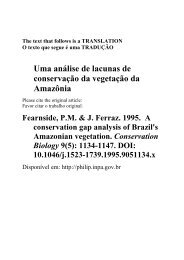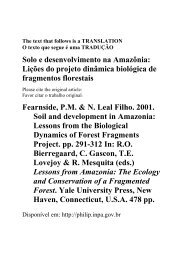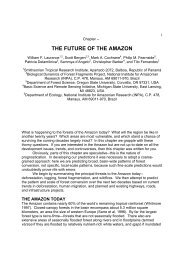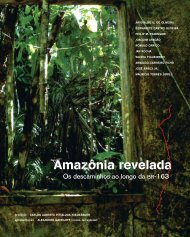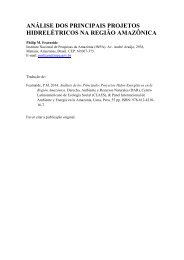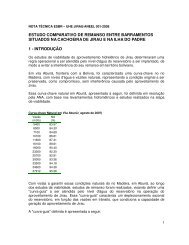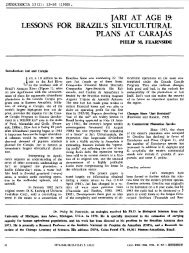the new jari - Philip M. Fearnside - Inpa
the new jari - Philip M. Fearnside - Inpa
the new jari - Philip M. Fearnside - Inpa
You also want an ePaper? Increase the reach of your titles
YUMPU automatically turns print PDFs into web optimized ePapers that Google loves.
have a synergistic effect with iron toxicitycontributing to reduced absorptionof nutrients by <strong>the</strong> rice plant. Theplants respond to roots being puncturedby stink bugs by replacing <strong>the</strong>m withadditional roots. Foliar symptoms ofnutrient deficiencies can easily lead to<strong>the</strong> conclusion that increased fertilizerapplications are needed, a response <strong>the</strong>current technical staff likens to treatinga human patient suffering from intestinalparasites by applying blood transfusionsor additional food. Increased attentionto insect problems may reduce <strong>the</strong> costand increase <strong>the</strong> effectiveness of futureresponses to <strong>the</strong>se symptoms.Nematodes are an additionalproblem found by <strong>the</strong> currentteam of technical staff, which beganwork at <strong>the</strong> IRI Research Institute stationassociated with <strong>the</strong> rice project in <strong>the</strong>latter part of 1980. The problem's severityand <strong>the</strong> possibility of control arestill under investigation. Aphids (Aphididae)in <strong>the</strong> rice roots and mites (Acari) ,are two additional problems discoveredby <strong>the</strong> present research team.Rice diseases presentinclude rice blast (Piricularia oryzae), towhich <strong>the</strong> IR-22 variety now being phasedout is very susceptible (but which didnot inflict economically significant lossesduring <strong>the</strong> time that IR-22 served as Jari'smainstay). Leaf scald (Rhynchoporiumoryzae) has been <strong>the</strong> most damagingdisease for both IR-22 and J-226. J-226seed is being propagated as a promisingreplacement for both IR-22 and <strong>the</strong> J-229progressively supplanting IR-22 since1979. Brown leaf spot (Helminthosporiumoryzae) is also present, as well as alittle false smut (Ustilagenoides virens).Although diseases represent a constantworry to rice growers, J ari's rice hasnot suffered unduly from <strong>the</strong>m sofar. "Hoja blanca" virus, a majorproblem in Venezuela, has still notarrived at J ari. The most effective responseto disease problems is generallya switch to more resistant varieties, chemicaltreatments representing only a temporarymeasure. The greatest problemis ability to produce sufficient seed fastenough to effect a variety change whenand outbreak occurs (given that a resistantvariety is available in <strong>the</strong> pool ofstrains undergoing testing at <strong>the</strong> site).Sufficient seed was not available to complete<strong>the</strong> switch from IR-22 to J-229two years after <strong>the</strong> change began, andJ-229 is now already slated for replacementas soon as enough J-226 seed isavailable.Weeds are a continualworry in <strong>the</strong> Jari rice project, as in irrigatedrice everywhere. Barnyard grass(Echinochloa crusgalli) is present at low334levels throughout <strong>the</strong> rice area, althoughit has not exploded to inflict <strong>the</strong> severelosses it is capable of causing. Wild redrice (Oryza rufipogon) is now present atJari's Sao Raimundo rice project in lowlevels. Wild red rice is a major problemin many parts of <strong>the</strong> world because it isdifficult to distinguish from domesticrice (0. sativa), many seeds fall from <strong>the</strong>panicles before harvest allowing it to reseedin <strong>the</strong> paddies, and any grainsharvested shatter when milled, thuslowering product quality. The most effectiveway to control <strong>the</strong>se and mosto<strong>the</strong>r weeds is to pre-flood <strong>the</strong> fields togerminate <strong>the</strong> weeds, followed by drain.ing and multiple herbicide sprayings priorto flooding and planting. These timeconsumingand expensive procedures areso far only used for <strong>the</strong> seed productionbeds. In production fields weed control ispresently limited to one spraying beforeplanting (ei<strong>the</strong>r Dalapon of Gramoxone),followed by spraying with Starn (Propanil)when <strong>the</strong> rice is growing. Onehigh spots. Ano<strong>the</strong>r engineering changebegan in 1980: construction of an additionalcanal through <strong>the</strong> middle of eachlarge field, allowing independent fillingof each of <strong>the</strong> paddies into which <strong>the</strong>large fields are divided. The <strong>new</strong> canalsreduce <strong>the</strong> time required to fill a paddyfrom eight days to 36 hours. The <strong>new</strong>canals in presently existing rice productionfields will be complete by <strong>the</strong> endof 1983, if <strong>the</strong> construction schedule isfollowed.Beginning in 1980, ricecrops are planted on a rolling basisra<strong>the</strong>r than in two distinctly separateand more synchronized cropping periods.The number of crops obtained from anygiven paddy is still limited to two, as<strong>the</strong> remaining time is insufficient for afull third crop. In <strong>the</strong> future <strong>the</strong> 1-226variety may allow about 30% of a fullcrop's yield to be harvested from resproutsas a stubble crop during this timeslot, but this possibility is still, in <strong>the</strong>testing phase. Rotation crops o<strong>the</strong>r thanPolitical and bureaucratic decisions affecting <strong>the</strong> sylviculturaloperation may have at least as much impact on its ultimate sustainabilityas <strong>the</strong> many biological and agronomic threats to continued production.marantaceous weed (Thalia geniculata)has not been sucessfully controlled with<strong>the</strong>se procedures, but <strong>the</strong> problem hasnot grown to economically damagingproportions. O<strong>the</strong>r weeds include an unidentifiedPhaseolus species, and ano<strong>the</strong>rwild rice species (Oryza alta). Two majorgraminaceous weeds in Surinam ( Barett,nd. (1975) ) not yet arrived at Jari(R. Cheaney, personal communication,1980) are Leptochloa scabea and Jschaemumrugosum. The latter is considered<strong>the</strong> "most dangerous grass inSurinam" (Doeven and Peorink, 1955,cited by Grist, 197 5: 280) .A number of remediesare underway for <strong>the</strong> various agronomicproblems and <strong>the</strong> decline in rice yieldsmay not continue if <strong>the</strong>se are effective.A major effort is improvement of <strong>the</strong>physical structure of fields and dikes toallow more finely tuned and rapid responsesto water management problems.Fields are being regraded at considerableexpense. Slight depressions and "highspots" in <strong>the</strong> present fields have been aconstant headache hampering uniformflooding or drying of fields to controlinsects, weeds or o<strong>the</strong>r problems. Armyworms, for example, preferentially attackrice are also being tested, including sweetpotatoes (Ipomoea batatas), maize (Zeamays), sunflowers (Helianthus annus),sorghum (Sorghum vulgare), cow-peas(Vigna sinensis), winged beans (Psophocarpustetragonolobus), soya beans (Glycinemax), peanuts (Arachis hypogaea),and an unidentified local legume greenmanure crop. Taro (Colocasia esculenta)is being tested as a potential alcoholcrop, and a native papyrus (Cyperusspp.) may be tested as a potential pulpsource. Rotation crops could help reducepest problems, as well as fertilizer costsin <strong>the</strong> case of green manure crops.The search continuesfor rice varieties more tolerant of suboptimalmanagement, and for varietieswith greater tolerance for iron toxicity.Variety screening continues, as well asresearch on possible rice managementchanges. Research on annual crops onterra firme (unflooded uplands) at SaoRaimundo was discontinued in 1979.Better insect populationmonitoring methods have been institutedin <strong>the</strong> irrigated rice fields (sweep nettransects ra<strong>the</strong>r than 1 m2 quadrats),and spraying programs have been adaptedto try and control more insect out-NOV- DEC 1982, VOL. 7 NQ 6 IIVERlJENJR


